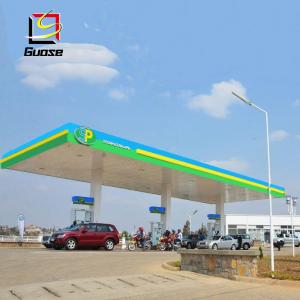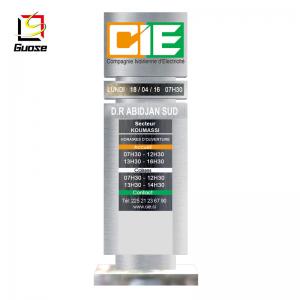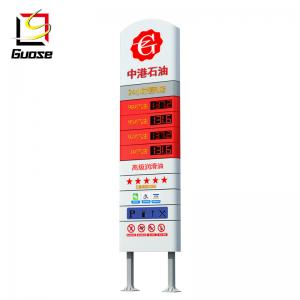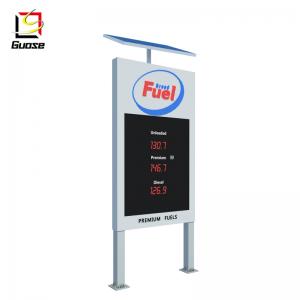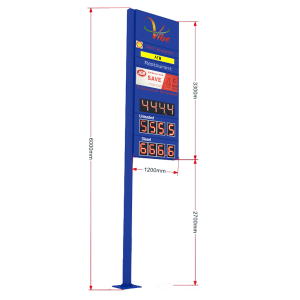Due to the special nature of the gas station, once the design does not meet the requirements of the specification, there will be hidden fire hazards that are difficult to find and rectify. In view of the fire hazard existing in the current gas station, Xiaobian Wang Zhen suggested that the following points should be noted in the design process:
1. Anti-corrosion treatment of oil tanks and oil pipelines
Oil tanks and oil pipelines must be treated with anti-corrosion treatment before being buried, and the corrosion resistance level should not be lower than the reinforcement level. The structure of the reinforced anti-corrosion coating is asphalt primer-asphalt-glass cloth-asphalt-glass cloth-asphalt-glass cloth-asphalt-polyvinyl chloride industrial film, the thickness of each layer is about, and the total thickness of the coating is greater than or equal to. Some gas stations only save labor, save money, or have short-term behaviors. Regardless of safety, they do not carry out anti-corrosion treatment according to regulations. Some even do not directly bury them underground. The consequence is that the oil tanks and oil pipelines are greatly shortened. The service life of the gas station leaves a hidden danger that is difficult to rectify.
2.Second, the gas station's layout and fire separation:
Gas stations should be located in places that meet fire safety requirements, convenient transportation, and away from hotels, restaurants, shopping malls, schools and other places. Gas stations include fueling areas and ancillary facilities. Some gas stations have power distribution rooms, boiler rooms, generator rooms, kitchens, employee duty lounges, etc., and should be arranged in a coordinated manner, and the auxiliary facilities should be separated as far as possible from the oil tanks and tankers of the oil vapor, and arranged. In the upper wind. New gas stations should fully consider the surrounding construction plan and leave enough fire separation.
3.Third, the tank foundation treatment:
Since direct-buried oil tanks are generally not prone to fire accidents, even if a tank fire accident occurs, it is easier to control and save. Compared with above-ground tanks, the safety factor is higher. The oil storage tanks at gas stations usually use straight-buried horizontal steel tanks. However, in areas where the groundwater level is high or where the groundwater level is difficult to determine, the oil tank may be lifted. The same arc should be made under the reinforcement ring of the tank, and the tank should be made of not less than flat steel. Fixed on the foundation to prevent empty cans from floating or misaligned. The oil tank in the water source protection area shall be protected by a concrete tank chamber. The inner wall of the tank shall be treated with anti-seepage treatment, and then the fine sand or fine soil shall be backfilled around the tank.
4. Setting of lightning protection and anti-static grounding device for oil tank, oil pipeline and fuel dispenser:
Oil can easily generate static electricity during the flow process. If it cannot be removed in time, the spark generated by electrostatic discharge can easily cause fire and explosion accidents. In order to avoid the discharge phenomenon caused by static electricity accumulation, oil tanks, oil pipelines, and fuel dispensers must be equipped with anti-static grounding devices. The lightning protection and anti-static grounding device of the oil tank shall have at least two grounding points. The buried depth of the grounding pole shall not be less than, and the distance between the two grounding poles shall not be less than. The grounding wire shall be galvanized flat steel or the diameter shall not be less than For round steel, the grounding resistance must not be greater than. The grounding device of anti-static and anti-inductive lightning should be installed at the beginning of the oil pipeline, and the grounding resistance should not be greater than. The static electricity of the tanker mainly comes from the static electricity brought by the oil from the pipeline, the static electricity generated by the fuel tank itself due to the oil flow and the friction of the pulley, and the static electricity brought by the fueler's human body to the fuel dispenser. The grounding resistance must not be greater than.
5. Process requirements for oil tank inlet pipes:
In order to avoid static electricity generated by oil splashing, the inlet pipe enters from the upper part of the tank manhole cover, and the end must extend into the tank bottom and be provided with an elbow. It is necessary to release a large amount of oil vapor when loading and unloading oil. It is the most dangerous fire operation process at the gas station. The oil inlet pipe should be equipped with a quick joint, and the oil should be unloaded in a closed manner or sealed by oil and gas circulation. When the oil is unloaded in a closed manner, it is not possible to avoid the escape of oil vapor from the discharge pipe, but the oil and gas circulation method should be used to unload the oil, and the tank truck and the gas station tank can be simply modified, at the tanker and the gas station. A gas phase line is added between the oil tanks to circulate the oil vapor in the oil tank of the tanker and the oil tank of the gas station, which can greatly reduce the evaporation of oil and gas. Gasoline and diesel tanks installed on the ground should be equipped with a breathing valve and a flame arrester.
6. Selection of electrical equipment in explosion hazardous areas:
It is necessary to select the corresponding electrical equipment model strictly according to the level of the explosion danger area of the gas station. It is forbidden to use non-explosion-proof electrical equipment in the explosion hazardous area. It is forbidden to install non-explosion-proof electrical appliances such as microcomputers and water dispensers in explosion danger areas such as fueling islands.
7. Installation of oil transfer line and power line:
Oil pipelines and power lines should be laid directly. When pipe trenching is required, the trenches must be filled with sand. When the trenches enter other buildings and firewalls, A sealed partition wall must be installed. The power line is strictly prohibited from being laid in the same way as the oil pipeline. When crossing the roadway, it should be protected by steel pipe.
8. The setting of the bottom valve of the tanker:
he purpose of installing the bottom valve on the suction pipe is that when the fuel dispenser stops working, the oil will not be in the reverse flow tank, so as to avoid the vacuuming machine to work under the next working time. Where the bottom of the tank is lower than the center of the tanker of the fuel dispenser, the bottom valve should be provided on the fuel supply pipe of the tanker. The suction pipe is generally close to the bottom of the tank. If it is too high, there will be a large amount of oil that cannot be pulled out too low. Water and dirt are sucked into the pump.
9.Tank ventilation safety device settings:
In order to avoid the oil tanks communicating with each other, affecting each other when cleaning the oil tanks, and when the oil tanks flow through the vent pipe to the adjacent tanks, each buried oil tank shall be separately provided with a vent pipe, and the diameter of the vent pipe shall not be less than The distance between the vent pipe nozzle and the gas station fence shall not be less than. Due to the daily variation of atmospheric temperature, it only affects the soil layer above the soil depth. The depth of the earthen horizontal tank is generally not less than that. The temperature of the gas space in the tank is relatively stable. There is no obvious change in the temperature between day and night. There is no need to consider the small respiratory loss caused by temperature changes. The breathing valve does not reduce the oil loss when breathing. It works, so there is no need to install a breathing valve. Installing a breathing valve increases the resistance during unloading and extends the unloading time. The flame damper must be installed at the nozzle of the snorkel to prevent the external fire source from entering the tank and causing an accident. The vent pipe of the petrol and diesel storage tanks buried directly in the gas station of the car must be installed.
10. Equipment for fire fighting facilities and equipment:
With the strict control of automobile exhaust emissions and environmental protection requirements, leaded gasoline is gradually replaced by unleaded gasoline. Unleaded gasoline uses a high-octane alcohol compound or an ether compound as an antiknock agent, and the amount is generally one. However, alcohol and ether additives are polar solvents. Due to the addition of these polar solvents, it is difficult to use ordinary foam fire extinguishing agents to extinguish unleaded gasoline compared with leaded gasoline. According to the recommendations of the American Fire Protection Association fire protection regulations, when the volume fraction of alcohol and ether additives contained in unleaded gasoline is greater than that, the fire extinguishing measures should be treated as polar solvents. Dry powder fire extinguishing agent or anti-solvent foam fire extinguishing agent should be provided. In addition to fire extinguishers, gas stations should also be equipped with fire-fighting equipment such as asbestos, fire-fighting sand, fire-fighting rafts and fire buckets. The fire extinguisher configuration should meet the following requirements: The number of dry powder fire extinguishers at each gas station should be the sum of the following two quantities. First, each fueling island should be equipped with a dry powder fire extinguisher. Only two oil filter units per ton of dry powder fire extinguishers are used. , should be configured only. Article 1 of the "Design Code for Small Oil Depots and Auto Gas Stations" stipulates that oil tanks should be set up only with cart-type dry powder fire extinguishers and cart-type high-efficiency chemical foam fire extinguishers, which is debatable. Since sodium bicarbonate dry powder fire extinguishing agent is incompatible with protein foam and chemical foam, and foam fire extinguisher is inconvenient and uneconomical to use, it should be equipped with the same type of dry powder fire extinguisher, which can be equipped with dry powder fire extinguisher only. For the gas station of the above-ground tank, a fire dam should be set up, and a fire pool or a water source capable of water resistance should be provided. At least a fire pump should be provided, and a corresponding fire hose and water gun should be equipped. In short, the design of gas stations must adhere to the principle of prevention, based on the actual and long-term, grasp several important links in the design process to ensure that no hidden dangers remain.








